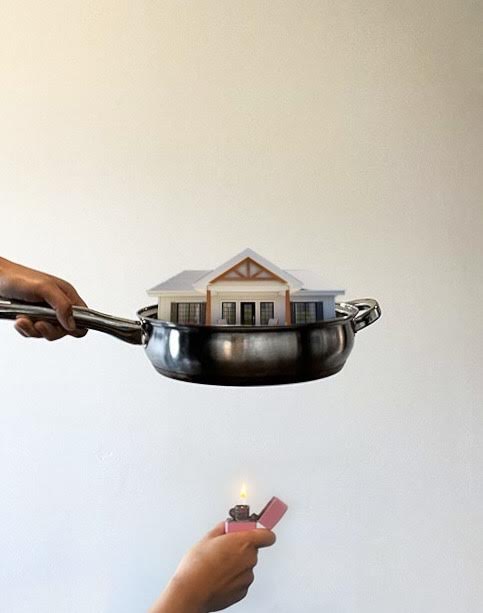Overheating Economy
Too much heat in summer can cause a fever, the same way too much heat in an economy can cause an economic fever. Signified by high growth through rising demand and prices, resources can no longer keep up, causing an overheating economy. This often leads to a crash as the economy needs to recover and cool down, just like normal fevers. But will the Dutch economy face a similar fever anytime soon?
The most important signs of an overheating economy are increased inflation and low unemployment rates. This signifies rapid economic growth due to increased demand, where suppliers try to allocate more resources to meet this demand[i]. Usually, this is achieved by hiring more workers to run more shifts, leading to a lowered unemployment rate. But also, by running machinery beyond their normal capabilities.[ii] This handling of resources is unsustainable and cannot be supported indefinitely. So, supply cannot meet the increasing demand, despite having an increased workforce. Due to both the increased demand, and more people in the economy having money to spend, prices rise. This makes money worth less, and it becomes less attractive to both consumers and companies to invest money in the economy.i
These hallmarks stagnant economic growth. [iii] Inflation rises, but the economy no longer grows. This means the economy is performing above it is natural output and is overheating. ii
There are several ways for governing bodies to cool down the economy once it starts to overheat. Most commonly this is done through raising interest rates, making investments less attractive.i This may seem counterintuitive as spending is already reduced. But this reduction is controlled by the central banks. By increasing interest rates, consumers are incentivized to save money.i This allows the economy to cool down with decreased demand, at a steady rate the governing bodies can control, instead of sudden economic shocks.
This also sets expectations for major economic agents, like big companies or investing firms, as it signals that the central banks are intent on controlling inflation.i
Increased interest rates also attract foreign capital. Saving in the domestic currency now yields a higher guaranteed return, and foreign investors like to take advantage of that.i An attractive currency is a strong currency. Consumers overseas want to pay extra for the domestic currency.i This appreciates the domestic currency which makes import cheaper, but also decreases the demand for exported goods. This in turn counteracts the pressure of the inflation by lowering the cost of imported goods, while the cost of domestic goods are still high keeping their demand low.i
Another effect of raising interest rates is making riskier asset investments less attractive. It is now easier to get a better guaranteed return than before. This curbs speculative spending.i Which brings us to the next sign of an overheating economy.
Speculative spending occurs when economic participants excessively invest in assets, causing asset bubbles. This leads to overpriced assets and is unsustainable.i
Some economic agents even take on additional debt to capitalize on the seemingly favorable economic environment. But when the bubble bursts the asset prices fall, and the debt holders and consumers take a hit.i The debts can no longer be paid back, and this usually leads to a fiscal crisis as the banks can no longer receive their money.i
A historical instance of overheating is Russia’s economy at the end of last century, after the fall of the Soviet Union.[iv] The country had to transition from a planned economy, common during communism, to a market-based economy, and the symptoms are like that of an overheating economy.
The most distinct difference between a planned economy and a market-based economy is the lack of price regulation in a free market.iv This change caused a brief period of hyperinflation, and a longer period of high inflation as prices soared.[v] Hyperinflation being a more extreme version of high inflation, at worst making a currency literally worthless.i
Many economic institutes in Russia also had to be established to operate a free economy, like commercial banks. This included privatizing enterprises and assets that previously were owned by the government.[vi]
Privatizing these assets led to speculative behavior and multiple asset bubbles were created, as now, for the first time, private consumers could own or partially own companies and their resources.[vii]
This excessive behavior was amplified by Russia opening up their domestic market to the rest of the world. Foreign investors saw the changes in Russia as a positive sign and the asset bubbles grew.vii
Free economies also have less wage regulation. The low wages suddenly spiked, causing the working class to have an increase in purchasing power.i This caused demand to increase, and the workforce was overemployed to keep up with this demand. This was a major contributor the extended period of high inflation in Russia.[viii]
It is clear that the Russian economy was overheating during this period, similar to the other Warsaw Pact states, as it is not often that a major economy must adjust to a market-economy model.vii But it took Russia a decade to stabilize with the regime of Putin.[ix]
A more classical example of overheating is the Chinese economy from 2003 to 2007.[x]
During this period China experience rapid economic growth, with rising asset prices, excessive investment, and high inflation.x
China was still growing and on its way to become the largest exporter in the world. To meet the worldwide demand for their products they invested in infrastructure and supported urbanization in the country. To support this the Chinese government held a loose monetary policy.x This meant low interest rates and little credit control to help investment in these sectors. i
This also meant that excessive and speculative investing was attractive and easy.i A major bubble developed around properties in major cities. Investors expected their values to keep increasing and wanted to take advantage of that.[xi]
Through this China gained an influx of foreign capital. But the country had to stretch its resources to their limit.xi Inevitably this meant supply could not keep up with demand and prices rose.x
But overheating economies were no longer a new phenomenon, and the Chinese government took the proper steps to let the economy cool off.x
First, interest rates were raised, to curb speculative investments. They also made borrowing more difficult, by having more stringent credit checks. This way the government controlled inflation, and the property market cooled down in 2007 as the bubble dissipated.x This was enough to prevent an economic collapse while still providing enough export to the rest of the world, leading them to now be the biggest exporter in the world.[xii]
One of the most well-known examples of overheating economies was the Weimar Republic during the early 1920s. After the first World War Germany had to pay reparations, on top of the loans they used to fund their war effort.[xiii]
To pay for the massive war debt they printed extra currency, the German Papiermark.xiii With the extra currency they bought foreign currency and paid back the debt, but they bought foreign currency at any price. Due to the extra Papiermark entering the circulation the value of the currency decreased. So, more Papiermark were required to buy foreign currency, and more Papiermark were printed to compensate. This devalued the currency even more, leading to a vicious cycle.[xiv] Prices skyrocketed in response, and inflation turned into hyperinflation. By 1922, Germany could no longer make the reparation payments as the Papiermark was worthless.xiii
With the currency falling so quickly in value the consumers immediately spend their money. Akin to speculative investing, they correctly figured that it was better to buy essentials sooner rather than later.xiii
The resources in the country had to be dedicated to meet this demand, and with a currency that had no value on the global market there was nothing to import. This meant that only by domestically produced goods could the demand be met, giving the economy no chance to cooldown.[xv]
While this is not the most conventional example of an overheating economy, as this crisis was rooted in financial debt and poor fiscal policy, the characteristics of the crisis were the same as with other overheating economies.i ii [xvi]
If we look at the Netherlands in 2023, we see that inflation has been trending high.xvii After COVID-19 companies are starting up again as well, anticipating an increase in demand as people can go outside again and freely spend money, instead of being limited to in-house activities. Companies are eager to make up for the losses during lockdown and bring in more workers. This puts the unemployment rate lower than usual.[xvii]
Wages are also rising in an attempt to attract more workers.xvii Paired with a low interest rate, remnant of the 2010s, the door is open for speculative investments.xvii In recent years we have seen the speculative bubble of crypto currencies and reddit stocks, and currently we have a bubble around the housing market.[xviii] [xix] [xx] But it is unlikely that the Dutch economy will overheat.
There is no trade deficit, and as part of the European Union, the European Central Bank (ECB) oversees the Euro.[xxi] [xxii]
The ECB tries to anticipate the coming economic environment and is slowly raising the interest rates.[xxiii] With this they hope to control the inflation and curb the rising prices.
But the success of this will also depend on the Dutch government themselves to not be fiscally irresponsible, and kickstart the economy in a controlled way. Only the results of the upcoming elections will tell how the Dutch government plans to do this.
Bibliography
[i] Mankiw, N. Gregory. Macroeconomics. Worth, 2022.
[ii] “Explainer – What Does Overheating in the Economy Mean?” Central Bank of Ireland, October 20, 2019. https://www.centralbank.ie/consumer-hub/explainers/what-does-overheating-in-the-economy-mean#:~:text=Overheating%20is%20when%20the%20economy,is%20very%20little%20available%20slack.
[iii] Team, The Investopedia. “Stagnation: Definition, How It Works, and Example.” Investopedia, June 30, 2023. https://www.investopedia.com/terms/s/stagnation.asp#:~:text=Stagnation%20is%20a%20prolonged%20period,(GDP)%20is%20considered%20stagnation.
[iv] ROSALSKY, GREG, MARY CHILDS, and JEFFREY SACHS. The day Russia adopted the free market. Other. NPR, May 6, 2022.
[v] Russian inflation, inflation rate in Russia, inflation rates, inflation calculator, rate of inflation in Russia on Russiansabroad.com, December 24, 2003. http://www.russiansabroad.com/russian_history_196.html.
[vi] Hertzfeld, Jeffrey M. “Joint Ventures: Saving the Soviets from PerestroikaJ.” Joint Ventures: Saving the Soviets from Perestroika, 1991.
[vii] Reynolds, Sue. Rep. Nuffield Poultry Study Group Visit Russia, 2007.
[viii] Oomes, Nienke, and Oksana Dynnikova. “The Utilization-Adjusted Output Gap: Is the Russian Economy Overheating?” IMF Working Papers 06, no. 68 (2006): 1. https://doi.org/10.5089/9781451863284.001.
[ix] Aris, Ben, and Ivan Tkachev. “Long Read: 20 Years of Russia’s Economy under Putin, in Numbers.” The Moscow Times, October 30, 2023. https://www.themoscowtimes.com/2019/08/19/long-read-russias-economy-under-putin-in-numbers-a66924.
[x] Yao, Shujie, and Minjia Chen. Issue brief. CHINA’S ECONOMY IN 2006: A HIGH GROWTH PATH TOWARDS A ‘HARMONIOUS SOCIETY’ . Nottingham: China Policy Institute, 2007.
[xi] Chung, Roy C., W. H. Ip, and S. L. Chan. “Impacts of the Overheating Economy on China’s Manufacturing Industry.” The International Journal of Advanced Manufacturing Technology 43, no. 11–12 (2008): 1133–43. https://doi.org/10.1007/s00170-008-1792-y.
[xii] Gang, Fan. “On Two Overheatings of China’s Economy.” China Development Institute, September 24, 2022. https://en.cdi.org.cn/component/k2/item/288-on-two-overheatings-of-china-s-economy.
[xiii] Evans, Richard J. The coming of the third reich. London: Penguin, 2004.
[xiv] Shapiro, Max. The penniless billionaires. New York: Times Books, 1980.
[xv] Parsson, Jens O. Dying of money: Lessons of the great german and American inflations. Indianapolis, IN: Dog Year Pub., 2011.
[xvi] Chen, James. “Overheated Economy: Factors That Contribute.” Investopedia, May 28, 2021. https://www.investopedia.com/terms/o/overheated_economy.asp#:~:text=Key%20Takeaways,normal%20rate%20for%20an%20economy.
[xvii] Centraal Bureau voor de Statistiek. “Dashboard Economie.” Centraal Bureau voor de Statistiek, October 31, 2023. https://www.cbs.nl/nl-nl/visualisaties/dashboard-economie.
[xviii] Egan, Matt, and Anna Bahney. “The Housing Market Looks like a Bubble, 2008 Regulator Says.” CNN Business. October 11, 2023.
[xix] Platt, Eric, Colby Smith, Madison Darbyshire, Alice Kantor, and Robin Wigglesworth. “‘This Is the Way’: The Reddit Traders Who Took on Wall Street’s Elite.” Financial Times. January 29, 2021.
[xx] Stafford, Philip, and Joe Rennison. “Crypto Trading Volumes Boom as Activity Cools on Stock Markets.” Financial Times, May 6, 2021.
[xxi] “Nederland Handelsland 2023: Export, Import En Investeringen – Een Introductie.” Den Haag, 2023.
[xxii] “European Central Bank (ECB).” European Union, June 4, 2023. https://european-union.europa.eu/institutions-law-budget/institutions-and-bodies/search-all-eu-institutions-and-bodies/european-central-bank-ecb_en#:~:text=The%20European%20Central%20Bank%20(ECB,economic%20growth%20and%20job%20creation.
[xxiii] European Central Bank. “Monetary Policy Decisions.” European Central Bank, July 27, 2023. https://www.ecb.europa.eu/press/pr/date/2023/html/ecb.mp230727~da80cfcf24.en.html.
Jai Ramlakhan is a BSc Econometrics student at the University of Amsterdam. Before that he finished an International Business degree in Rotterdam. During his studies he likes to use math to examine the economical models he learned and compare those to recent events.
He is a curious student that likes to expand his horizons. Currently that includes learning how to cook and restoring retro video game consoles.
Ashley Miya is a third year BA student at Seattle University studying Photography with a minor in Studio Art. She has worked in Social Media for multiple platforms, is a current photography intern and does private and commercial photography. Ashley loves travel, culture, and building community. One of her favorite travel experiences was the opportunity to teach underprivileged children in Myanmar. In her free time she is often found exploring art, music, dance and just being creative.


